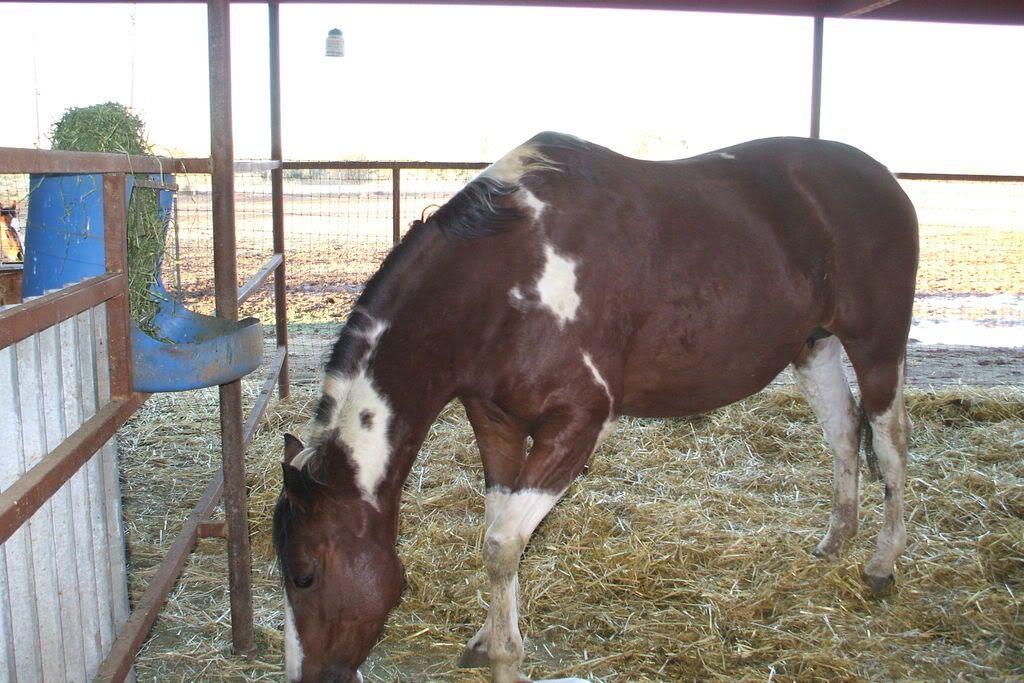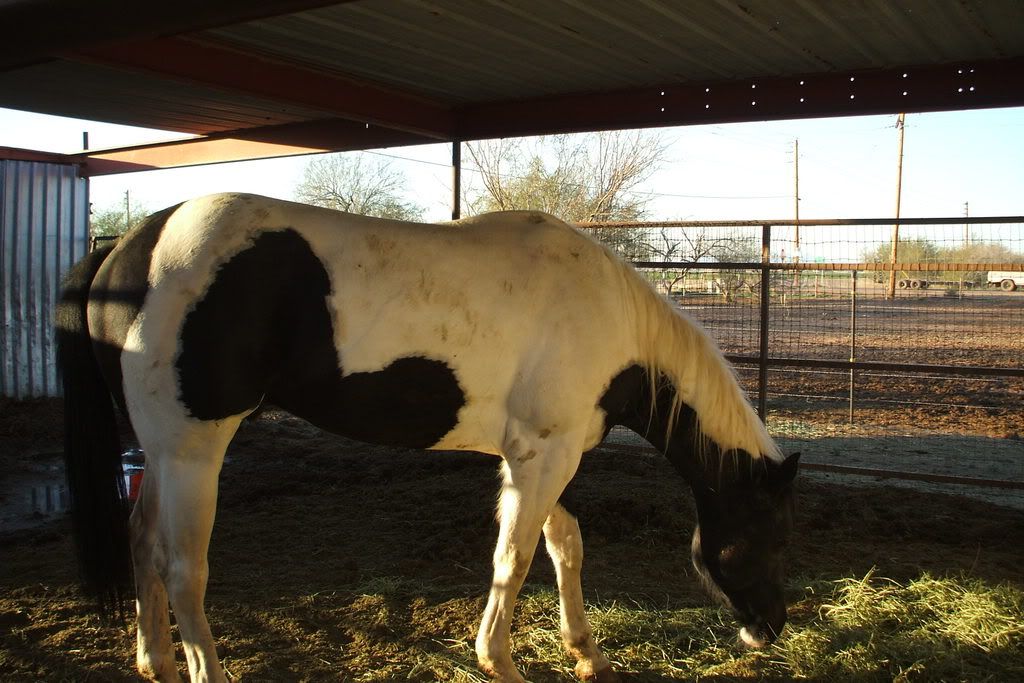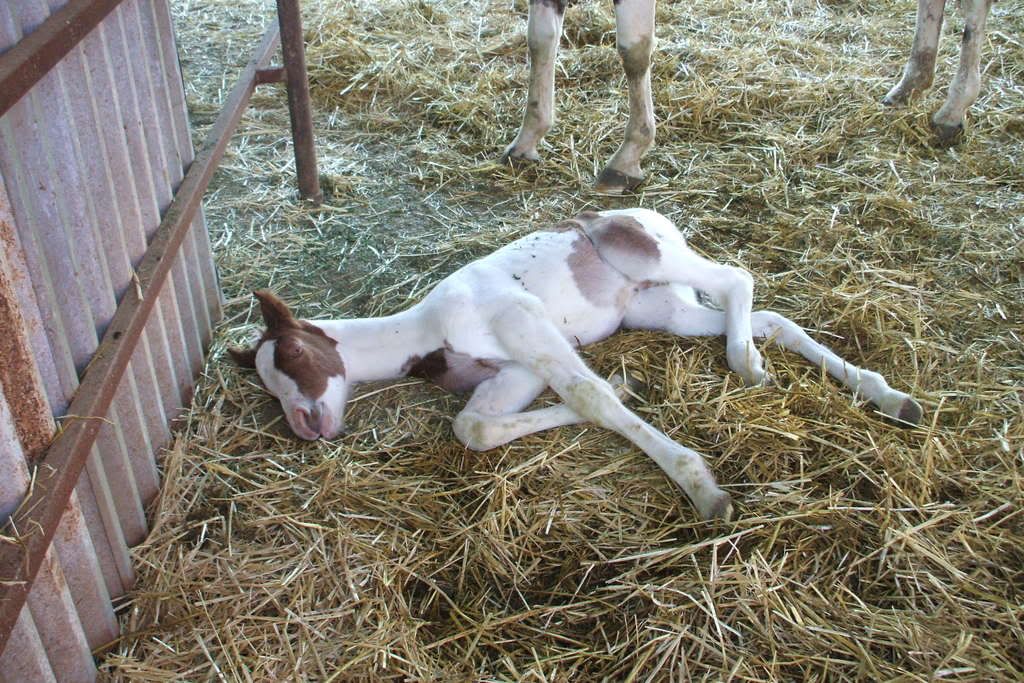|
|
Post by nrly on Jan 28, 2008 23:28:49 GMT -5
My black and white paint is bred to a black and white stallion with the H gene ( I can not spell it and wont try). the owner of the Stud says he can guarantee me a black and white. this is my mares 4the pregnancy, one she sluffed, all the others were solids.
here is my question?
just because the Stallion has that H gene. He can not guarantee me a black and white. Right? I just do not get this attitude.
One of the mares he cover just gave birth, and the baby is liver colored and white more white like the Stallion, and I know the foal can change colors, they are saying either bay or black. now the mom is a pinto, liver colored, tri colored main and tail. will get a picture of momma and baby, and the stallion and post it so you can see.
|
|
|
|
Post by sonrisa98 on Jan 29, 2008 1:25:32 GMT -5
a friend of ours bred his black and white mare to a red dun stallion hoping for a dun pinto and what he got was a spitting image of the mom. I'll post a pic.
|
|
|
|
Post by Michelle Clarke on Jan 29, 2008 9:05:04 GMT -5
I am guessing the H stands for Homozygous. Each horse has a double set of genes (one for each factor if you will), they receive one from the sire and one from the dam. Out of each pair, one is dominant or at least more dominant than the other. This is the one that "shows up".
If a horse is Homozygous in it's set of genes, like say the pinto coloring, then he will throw the pinto color 100% of the time into the dna makeup. Your mare, though she is pinto, is not homozygous, in proof that she has thrown solid colored foals.
Since the pinto coloring is dominant, meaning if they have the gene it will show, then you will have a pinto colored foal if the sire is homozygous for the pinto gene.
If the stallion is also homozygous for black (meaning he carries no red), the foal will be black based, as black is dominant over red, even if your mare carries it. Your foal will not be bay, as the bay shows up on black if they have it and both the sire and dam are black, so no bay...
If your mare has had foals before and none of them were red based, then you might guess she does not carry the red gene (of course it depends on who she was bred to), so you may get black based. If she has had a red foal, then she carries the red gene and can throw red based babies if the sire also carries red.
If the baby that just hit the ground is actually red based, then the stud carries red and can throw red when paired with a mare that also has red. The foal could be bay, which means either the mare is bay or red and hides a bay.
With all this info, you do have like a 93% chance of the foal being black based and the other red. If the stud is both homozygous for pinto and black, then you will get a black pinto because your mare does not carry the bay gene - guaranteed.
|
|
|
|
Post by sonrisa98 on Jan 29, 2008 10:02:54 GMT -5
 Couldn't get into photobucket last night. Here's the pic of the mare and foal I was talking about. |
|
|
|
Post by nrly on Jan 29, 2008 13:06:30 GMT -5
yes that is the H gene, and that picture of that baby is exactly what this baby looks like. Will get the pictures tonight. They did say that they think that the baby will darken to a bay or black, but I just can't see it. but thank you for the explanation, I understand it allot better now.
|
|
|
|
Post by sonrisa98 on Jan 29, 2008 19:29:28 GMT -5
the little filly in the pic actually shedded out black like her mom. She's bred to the same stud again and I'll be suprised if the foal is any other color then black and white.
|
|
|
|
Post by nrly on Jan 29, 2008 21:26:55 GMT -5
cool can't wait to see how he will turn out.
|
|
|
|
Post by spanishsagegrullas on Jan 29, 2008 22:35:11 GMT -5
Genetics and inheritance is quite often a complex and tricky matter, when one is trying to predict the outcome. Not only do you have dominant traits, recessive traits, but also modifying traits, traits that express as incomplete dominance, etc. But to simplify it, as with your standard horse colors, we can say that each horse inherits one gene from the sire, one from the dam. The dominant gene will always be expressed. Thus it doesn't do any good to try to breed two opposite traits in the hopes of getting something in them middle. Think about if you had a crooked legged horse that for some bizarre reason you had to breed. You certainly would not look for another horse that had legs crooked in the opposite direction in the hopes you ended up with a straight leg! With horse colors, for base colors of red and black, you have a dominant E that indicated that your horse is black based. If your horse did not inherit any Es from either parent, then it is ee, therefore red based. E indicated presence of the ability to produce a horse that expresses black. What modifies WHERE the black is expressed -- on the whole body, therefore having a black horse, or on just the points, the lower legs, the mane and tail, therefore giving you a bay horse, is called the Agouti gene, A The presence of the dominant agouti gene A, causes the black to be limitted to the points, and you have a bay horse. Bay horse ARE black based. If you do not have an A, therefore having a homozygous recessive aa, you will have a fully black horse. However, Agouti has no effect on red, only black, so that if you have a red horse (chestnut or red dun) it can genetically carry the A, the Agouti, but you would not see the black being limitted to the points, since the ee limits the horse's ability to express black as a pigment. If your person says his horse is homozygous black and will only produce black, then he is representing that the horse is tested EE aa. HOWEVER, he actually cannot guarantee that the product will be black not bay if bred with another bay-based horse, because that other horse might contribute the A gene, and thus produce a bay. He can really only say it will be black based. I will try to find some good and basic web sites on horse color genetics. I think there is a pretty good link and description from the UCDavis Veterinary Genetics Lab, www.vgl.ucdavis.edu They do quite a bit of equine coat color testing there. Did that help? Or did it confuse you more? Sorry if it did.... Diane P. Spanish Sage Ranch |
|
|
|
Post by Michelle Clarke on Jan 30, 2008 8:42:46 GMT -5
Quite interesting when a gene can be inherited for the same factor for each side. Color is the easiest example, so I will use that. Sycha has the dun modfier. The horse she was bred to last year carried 2 creme genes which means he will pass one onto each foal he produces. Her foal received a trait from both sides.....creme from the sire and dun from the mare. I wonder how that works in other paired aspects?? Some folks say it is one or the other, but that obviously is not true, it can be a mixture from both sides of the chain.
|
|
|
|
Post by spanishsagegrullas on Jan 30, 2008 10:21:24 GMT -5
Each characteristic has a dominant or a recessive aspect to them, controlling for an identical characteristic. These are called alleles. The alleles are located on the genes that control the characteristic. On rare occassions, there are alternate alleles which can also occupy the paired location. These are complicated and not common. When you hear it said that it is not an alternate allele, that means that gene is located on a different location on the chromosome. At times, due to the proximity of the genes, they are inherited together, but are certainly capable of being inherited separately.
Dun would not be an alternate allele for cream; you can and do have a horse that has cream and dun inherited from one parent.
It's when you get into the more complicated incomplete dominance issues, etc, that it is not as clear cut. For the colors that we are dealing with in the Kiger, it is pretty clear cut -- dominant vs. recessive, heterozygous (presence of both a dominant allele and a recessive allele) and homoygous (both dominant or both recessive.) That's a blessing for us!
Diane P.
Spanish Sage Ranch
|
|
|
|
Post by DianneC on Jan 30, 2008 11:40:54 GMT -5
Just went to a cool site for people really interested in learning about this in depth. Its at www.ksu.edu/biology/pob/genetics/intro.htm I got a little confused by the term gamete but am pretty sure it means the egg or sperm. Each parent's dna splits so that their egg or sperm has 1/2 of their genetic material. How the dna splits and which sperm fertilizes the egg determines what gene the baby gets. i.e. a stallion with one red gene and one black gene will produce 50% sperm with red and 50% with black. The color of the baby is determined by which sperm fertilizes the egg and what color the dam contributed from her dna in making the egg. What is the BEST is if you click on hints they will show you how to make a punnett square, something like a tic-tac-toe square that enables you to figure out what are the possible gene combinations that could be inherited. Cool! They talk about incomplete dominance too, like where a red flower and a white flower make some pink flowers. |
|
|
|
Post by nrly on Jan 30, 2008 13:24:50 GMT -5
this is the mother of the baby   this is the sire, who my mare is bred to.  |
|
|
|
Post by nrly on Jan 30, 2008 13:45:39 GMT -5
he is so cute, this sire is the one with the H gene. This baby's momma is a pinto, the stud is a registered paint. but this stud tends to be dingy. he is the tru tru line.
|
|
|
|
Post by DianneC on Jan 30, 2008 16:06:12 GMT -5
If he is homozygous for black then the foal pictured has to be bay, like the dam (tri-colored), although from the angle of the picture the foal looks chestnut. The foal would have black in its mane and tail, even newly born if it was bay. If the foal is really chestnut then the stallion isn't homozygous for black, but has one black gene and one red gene. What color were the solid foals out of your mare? Are the foals of this stallion dingy as well?
|
|
|
|
Post by fantasykiger on Jan 30, 2008 16:39:17 GMT -5
I think the stud owner is playing the odds, she is assuming sense her stud is black and white and your mare is black and white, that she can say "she can guarantee you a black and white foal" with out much chance you will have a recessive characteristic foal come about, such as a chestnut foal.
Of course she knows she can guarantee you spots as he is Homozygous for the tobiano pattern. Although from the picture you posted of the stud I do not see any ink spots on the stud that would be an indicator to me that he is Homozygous for the tobiano pattern. But I am sure the stud owner had him tested in order to make you that guarantee.
|
|